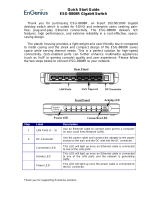
ESG WHITE PAPER
Symantec’s Data Management Portfolio
- 4 -
Copyright 2009, The Enterprise Strategy Group, Inc. All Rights Reserved.
to set aside a “backup window,” which, in traditional methods of backing up systems, might disrupt normal
operations. Backup images can be stored on disk, removable media, or FTP locations. In the case of server
virtualization environments, images may be moved between physical and virtual machines.
NetBackup Data Protection with PureDisk Data Deduplication
NetBackup enables disk-to-disk, disk-to-tape, and disk-to-disk-to-tape data protection. IT organizations can
establish different backup and recovery policies depending on the location and type of workloads to be protected.
Data on Windows, Linux, and UNIX systems—including virtual machines running on VMware and Microsoft
hypervisors—in a data center or distributed in remote or branch offices can be centrally managed with
NetBackup. It provides file- or image-level backup/recovery to or from disk, physical tape, or virtual tape.
For disk-based backup, NetBackup PureDisk data deduplication can be applied to optimize the capacity of data
stored and transferred across the WAN, LAN, and SAN. Full backup and virtual machine images represent a lot
of redundant data, affecting the amount of data traversing the network, the footprint of disk storage, and power
and cooling requirements for secondary storage. These constraints may impact the frequency of backups
performed and the length of time they are retained on disk, which, in turn, could affect IT’s ability to minimize
downtime and data loss. NetBackup PureDisk deduplication addresses these issues by deduplicating within and
across backups to deliver savings in bandwidth and storage capacity.
Veritas Backup Reporter
Veritas Backup Reporter adds another layer of visibility into the backup environment—above and beyond the
basic information (events, storage assets, performance metrics, capacity trending, SLA and compliance metrics,
etc.) provided by backup applications. It collects, aggregates, and stores data about the systems, platforms,
devices, and backup processes in the data protection environment in a relational database—without requiring the
installation of agents. Instead of manually collecting log data and analyzing it to determine the root cause,
Veritas Backup Reporter offers hundreds of out-of-the-box and customized reports to automate and speed the
forensic process. And, Veritas Backup Reporter doesn’t provide a myopic view of the environment as data is
aggregated across domains from a variety of backup vendors’ solutions.
Symantec Protection Network Online Backup and Online Storage Services
Symantec Protection Network (SPN) is Symantec’s software-as-a-service (SaaS) platform, enabling the delivery
of services via a Web-based application and information storage “in the cloud.” Today, SPN services include
online backup and online storage for offsite backup copies. SPN online backup captures data based on specified
policies, transfers it to SPN’s data center storage, and retains it for the term of the service plan—basic (1 year) or
premium (7 years). Subscribers eliminate the need for on-premise capital investments and operational staff.
SPN online storage is a cloud-based electronic vault for backups, eliminating the need to create physical media
and transport it offsite for disaster recovery purposes.
Enterprise Vault Data Archiving, Migration, and Long-Term Retention
Enterprise Vault archives, manages, and enables discovery of corporate data scattered across any number of
applications, including messaging systems (e-mail and instant message), file servers, and content management
and collaboration systems. It captures content, assigns and enforces retention periods, and indexes information
as it is archived for enhanced search and retrieval. Why is this necessary? It addresses system optimization
and complies with regulatory mandates. The quantity of e-mail systems, users, messages per user, and
message retention periods have created message stores that are experiencing relentless growth—which in turn
impacts application performance and primary and secondary storage capacity (and TCO). Pruning the
environment to reduce the burden is a challenge directly addressed by e-mail archiving solutions. The other
challenge—supporting compliance and litigation events—is also addressed as Enterprise Vault maintains
unalterable copies of e-mail and attachments for mandated timeframes and facilitates the rapid retrieval of
electronic evidence.









